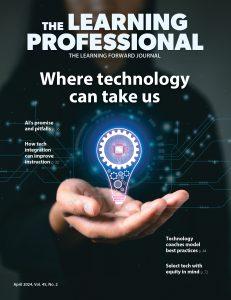Principals play a crucial role in student achievement and school success (Grissom, 2021), yet can experience “ad hoc” professional learning that has little connection to strengthening the skills they need to be effective leaders.
Fortunately, thanks to decades of research, we know much about content and learning approaches that are especially effective for developing excellent school leaders and equipping them to handle the real-world demands of the role. Also good news: Access to high-quality learning for principals has measurably improved over the past decade (Darling-Hammond et al., 2022).
That more attention is focused on the needs of principals and aspiring principals is cause for celebration. Learning Forward’s 2023 Annual Conference in December will feature more than 45 sessions on leadership development and serve as a hub for school leaders to gather and learn from each other in a collaborative environment. One district poised to share how it is maximizing capacity and engagement of its campus principals and assistant principals is Friendswood Independent School District, Texas, which centers its leadership improvement efforts in Standards for Professional Learning.
Learning principals: Embracing standards & effective behaviors
In their 2021 study, Jason Grissom and colleagues identified four principal practices that drive successful schools: they create a productive climate for learning; engage in instructionally focused interactions with teachers; facilitate collaborative and professional learning communities, and; excel in strategic management of key resources, such as instructional staff members. Mastering these practices requires principals to develop strong skillsets around people, instruction, and organization, so they can nurture trusting relationships with students and staff, leverage observational and evaluation strategies, and coach teachers and teaching teams to use high-leverage instructional practices.
Learning principals consider themselves the chief learner in the school. They are driven by a deep intention to make a substantive difference in the lives and successes of all in their school. Learning principals constantly strive to identify and take actions that ensure equity and excellence for all. (Psencik, Brown, Hirsh, 2021)
What is the professional learning system that is most effective for principals? Districts that prioritize hiqh-quality principal professional learning may have different designs but they all have similar attributes:
- District leaders understand the critical skills principals have to lead high-performing schools and keep an intentional focus on ongoing learning systems for them.
- The system is grounded in the Learning Forward Standards for Professional Learning.
- Principals self-assess their strengths and challenges on the Professional Standards for Educational Leaders connected to Grissom’s aspects of climate, instruction, and professional learning. They establish a learning goal for themselves.
- Principals work in learning communities and use their own professional learning goal, data from their student and staff performance, and goals of their district, to establish a problem of practice to guide their learning.
- An external facilitator working alongside the principal supervisors engages each learning community and principal in short cycles of continuous improvement.
- The principal supervisor and leadership coach are partners in ensuring principal learning. Each time the facilitator is coaching a team of principals, the supervisors are following up on the work of the principals as they visit their schools, host principal meetings, and observe the principal learning community in action.
- Principals’ communities of practice employ a variety of learning designs to learn by doing. Principals in their learning communities visit each other’s schools, observe principals working with a learning community of teachers or engage teachers in professional learning, and support each other as they work to develop new skills and achieve their goals. They often co-develop professional learning sessions or practice coaching together.
Ensuring the continuous improvement cycle is authentic
Supervisors and facilitators can help make sure that principals experience the learning cycle in its entirely through various methods:
- Using adult and student data to determine their progress on their goals.
- Setting strategic goals for themselves.
- Designing their own learning: Analyzing the cycles of continuous improvement of their teaching teams and the impact of those cycles on student achievement, analyzing teacher instructional designs as to their rigor or connections to the students they serve, observing each other facilitating professional learning, coaching each other and monitoring progress.
- Engaging in that learning with intent. For example, letting the staff know, “I am going to be trying something new today that I have been learning so that I am more effective as your principal. I am going to ask for your reflections at the end.”
- Ensuring monthly the principal teams have ample time to share out what they are learning and the impact that learning has on others.
Coaching is critical to principal success
Skilled coaches provide ongoing personalized support as principals work through all the issues we all face when learning new skills and behaviors. To build the trust that sustains relationships over time, coaches work to develop at least six traits based on the work of Daniel Goleman (2002), Megan Tschannen-Moran (2004), Julio Olalla (2003), and Stephen Covey (2008). I refer to the six traits as the “Six Trusty Oak Roots” and described them in “The character of a coach.” The attributes are: self-awareness, honesty, sincerity, competence, reliability, and the ability to be other-centered.
Friendswood ISD in Galveston County, Texas, contacted me a year ago and shared that they desired to provide professional learning for their principals because they believed they deserved time devoted to their own learning in order to grow in their leadership and practice. Their principals meet monthly to deeper learning experiences around the Standards for Professional Learning, apply what they are learning to their problem of practice by designing learning for adults and capitalize on the tools that are in their text, “The Learning Principal.” They support each other in a learning community. They spend time in each other’s buildings, coaching each other, observing professional learning, and reflecting on the quality of the work. They are successful because their principal supervisors attend and participate in all the sessions with their principals and follow up between sessions with individual meetings to make sure everyone stays focused. They have so much energy among the principal core that the superintendent’s cabinet is going to become a learning community so that all are focused on professional learning as the way to achieve the district’s mission and goals.
Research shows that principals’ impact on students is second only to teachers (Grissom et al., 2021). School districts that best meet the needs of their principals design professional learning that is ongoing for the principal’s entire career. Principal learning must be a continuous support system that assists principals working collaboratively with other principals in engaging in instruction conversations and interactions with teachers and teaching teams. Through their learning, they build a climate that fosters high regard for student and staff learning, and ensures all principals have the ownership of their own learning and the learning of everyone they touch.
Resource:
The Learning Principal: Becoming a Learning Leader
References
Bush, T. (2019). Professional learning communities and instructional leadership: A collaborative approach to leading learning? Educational Management Administration & Leadership, 47(6), 839–842.
Grissom, J.; Egalite, A.; Lindsay, C. (2021). “How Principals Affect Students and Schools: A Systematic Synthesis of Two Decades of Research.” The Wallace Foundation.
O’Neill, M. R., & Glasson, S. (2019). Revitalizing professional learning for experienced principals: Energy versus ennui. Educational Management Administration & Leadership, 47(6), 887–908.
Psencik, K; Brown, F.; Hirsh, S. (2021) “The Learning Principal.” OH: Oxford: Learning Forward.
Psencik, K.; Ebell, S.; McCulley, L. (2015) The character of a coach. The Learning Professional.
Sahlin, S. (2023). Professional development of school principals – how do experienced school leaders make sense of their professional learning? Educational Management Administration & Leadership, 0(0).








